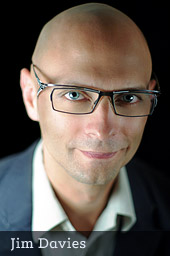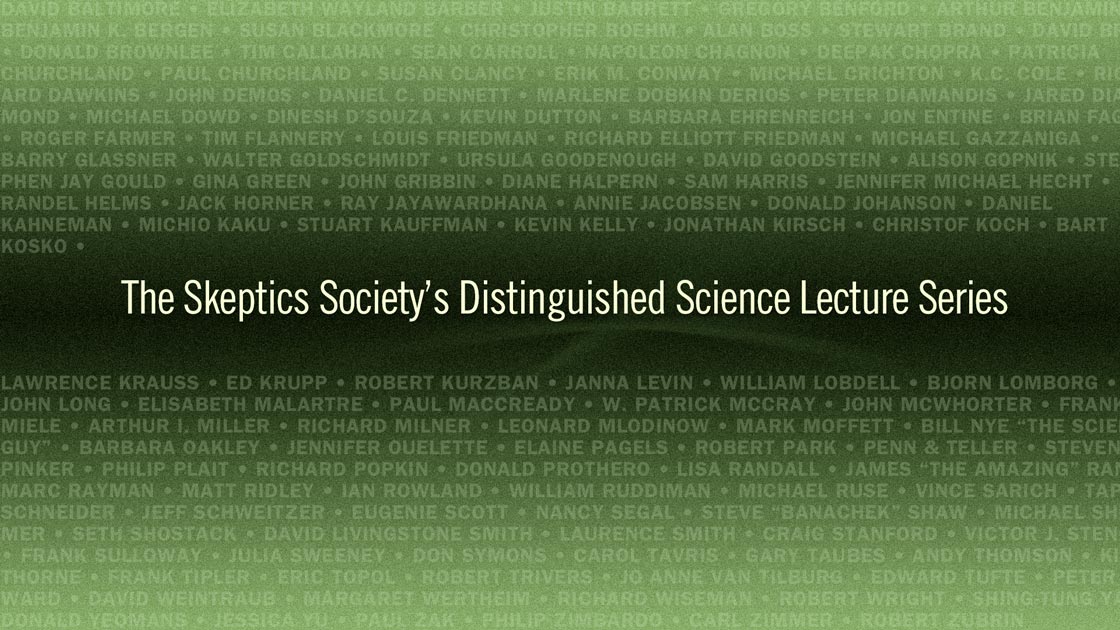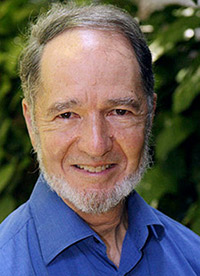In this week’s eSkeptic:
Our Next Science Lecture

Wizards, Aliens, and Starships: Physics and Math in Fantasy and Science Fiction
with Dr. Charles Adler
Sun., Feb. 16, 2014 at 2 pm
From teleportation and space elevators to alien contact and interstellar travel, science fiction and fantasy writers have come up with some brilliant and innovative ideas. Yet how plausible are these ideas? Which concepts might actually happen, and which ones wouldn’t work at all? A professor of physics at St. Mary’s College of Maryland, Adler delves into the most extraordinary details in science fiction and fantasy—time warps, shape changing, rocket launches, and illumination by floating candle—and shows readers the physics and math behind the phenomena. From the works of Ursula K. Le Guin to Star Trek and Avatar, Adler considers what might become reality. He examines space travel and wonders why it isn’t cheaper and more common today, and discusses exoplanets and how the search for alien life has shifted from radio communications to space-based telescopes. He concludes by investigating the future survival of humanity and other intelligent races. Order Wizards, Aliens, and Starships from Amazon.
Past Lectures Now Available on DVD
- Born Together-Reared Apart:
The Landmark Minnesota Twin Study, by Nancy Segal - The Wisdom of Psychopaths: What Saints, Spies, and Serial Killers Can Teach Us About Success, by Kevin Dutton
- The Particle at the End of the Universe: How the Hunt for the Higgs Boson Leads Us to the Edge of a New World,
by Sean Carroll - Near-Earth Objects: Finding Them Before They Find Us,
by Donald Yeomans - The Moral Molecule: The Source of Love and Prosperity,
by Paul Zak - The Visioneers: How a Group of Elite Scientists Pursued Space Colonies, Nanotechnologies, and a Limitless Future,
by W. Patrick McCray - Louder Than Words: The New Science of How the Mind Makes Meaning, by Benjamin K. Bergen
- Odd Couples: Extraordinary Differences between the Sexes in the Animal Kingdom, by Daphne J. Fairbairn

MonsterTalk # 77
You Won’t Believe What These Skeptics
Have To Say About Bigfoot
Sharon Hill (Doubtful News) joins us to discuss the recent history of Bigfoot bodies. From bigfoot steaks to Russian slavers, it’s time to catch up on some sasquatch news.
About this week’s eSkeptic

photo by Dan Thompson Photography
Much of postmodern writing is deliberately obscure and nonsensical, indistinguishable from parody. It’s easy to mistake obscurity for profundity. What is so enticing about a scholarly approach that results in texts that can scarcely be understood? Why would a whole scholarly subculture prefer to write and read unclear prose? What are they getting out of it? In this week’s eSkeptic, Jim Davies shares his ideas on the psychological attraction of postmodern nonsense. This article appeared in Skeptic magazine issue 17.4 (2012).
Dr. Jim Davies is an associate professor of cognitive science at Carleton University in Ottawa. The ideas in this article are from his book, Riveted: The Science of Why Jokes Make Us Laugh, Movies Make Us Cry, and Religion Makes Us Feel One with the Universe, available August 5, 2014.
Share this article with friends online. Click the + for more options.
Subscribe | Donate | Watch Lectures | Shop

Illustration by Nancy Norcross-White
Academic Obfuscations:
The Psychological Attraction of
Postmodern Nonsense
by Jim Davies
Postmodernism is an intellectual approach used in fields such as literary theory, sociology, and architecture. Although the term describes a broad class of viewpoints, in general postmodernism rejects the ideas of absolute truth and objective reality. Rather, it emphasizes how we construct our apparent realities by describing them, particularly through language.1 A salient aspect of postmodern theory is the dense prose common to some humanities disciplines. Here is an example from a 1982 book entitled Powers of Horror: An Essay on Abjection by Julia Kristeva:
There looms, within abjection, one of those violent, dark revolts of being, directed against a threat that seems to emanate from an exorbitant outside or inside, ejected beyond the scope of the possible, the tolerable, the thinkable. It lies there, quite close, but it cannot be assimilated. It beseeches, worries, and fascinates desire, which, nevertheless, does not let itself be seduced.2
Philosopher John Searle once asked Michel Foucault why his writing was so obtuse, when he was so easily understandable in conversation. Foucault told Searle that 25 percent of one’s writing needs to be incomprehensible nonsense to be taken seriously by French philosophers.3 Although Foucault rejected the postmodern label, he did believe that knowledge was generated through operations of power and his attitude reveals the intent of postmodernism to deliberately obscure.4
To emphasize the point, in 1996 a New York University physicist and mathematician named Alan Sokal penned a nonsensical article entitled “Transgressing the Boundaries: Toward a Transformative Hermeneutics of Quantum Gravity.” Loaded with postmodern phrases and deconstructionist tropes interspersed with scientific jargon, Sokal submitted it to the journal Social Text, one of two leading publications frequented by fashionably obtuse postmodernists. Here is an example from the article:
It has thus become increasingly apparent that physical “reality”, no less than social “reality”, is at bottom a social and linguistic construct; that scientific “knowledge”, far from being objective, reflects and encodes the dominant ideologies and power relations of the culture that produced it; that the truth claims of science are inherently theory-laden and self-referential; and consequently, that the discourse of the scientific community, for all its undeniable value, cannot assert a privileged epistemological status with respect to counter-hegemonic narratives emanating from dissident or marginalized communities.
The article was accepted for publication and upon release Sokal revealed it was all a hoax, and did so in the postmodern journal Dissent, the chief competitor of Social Text. Sokal called it a nonsense parody, but because so much of what passes for postmodernism is nonsense and indistinguishable from parody, the editors of Social Text could not tell the difference!5
Idea Effort Justification
It’s fun to tell stories making fun of postmodernism’s literary excesses, but there is a deeper mystery here. What is so enticing about a scholarly approach that results in texts that can scarcely be understood? Why would a whole scholarly subculture prefer to write and read unclear prose? What are they getting out of it?
No simple answer explains all of postmodernism’s charms. Part of it might be the fact that the content focuses on something important: that many ideas cultures have are indeed socially constructed, and not based on some objective reality. For example, in many Christian churches men are supposed to remove their hats, while in many Jewish synagogues men are supposed to put them on. So I don’t want to give the impression that the draw of postmodernism is only due to a bunch of cognitive quirks. Obscured content is not necessarily bad content.
So what is the pull of obscure writing, of which some postmodern writing happens to be an example? I argue that some prefer it because each reader has to do so much work to get any meaning out of it, and when we have to work hard for something, we really value it. We can mistake obscurity for profundity.
In the realm of communication, I call this “idea effort justification,” and it happens for many reasons.
The harder you have to work for something, the more you value it.6 This effect is called “effort justification,” and is used to explain, in part, why fraternity hazing, certain religious initiation rites, and military boot camps make people love membership in the very organizations that tormented them. Membership in a fraternity or placement in the army is more valuable because you went through hell to get it.
Just as people sometimes value things when they pay more for them, they take the expense of something to be an indicator of its value. It is a way of reducing cognitive dissonance: if you’ve worked hard for something, you will feel like an idiot if you believe that it’s not valuable. One way to resolve the conflict is to believe that what you worked for is great after all. You made sacrifices for it, in terms of money, time, or effort, and if the thing you worked so hard for is valuable, then what you did makes sense. Idea effort justification applies this concept to the ideas we encounter and generate.
When writing is clear, the reader does not have to work hard to understand it. But if people have to work hard to get a meaning out of a passage, then that resulting meaning will be of more value to them.
An idea—a belief, interpretation, or meaning— that is inferred or otherwise discovered by the reader is valued more by that reader than the same idea that is simply presented, in part, because it justifies the effort made to come up with it in the first place. Some postmodernists have even been explicit about this, noting for example: “It is the reader who writes the text.”7
The Pleasure of Figuring Out
When a person encounters something puzzling, such as a mystery or a riddle, the discovery of the solution brings with it a rush of pleasure. Readers of poetry and postmodernism alike work very hard to make sense out of what they are reading. That effort results in an “a-ha” moment when they gain some insight and figure something out. Through simple association, the resultant idea now feels pleasurable. We like pleasurable ideas.
We Like Our Own Ideas
We like an idea better if we came up with it ourselves, and we are more skeptical of ideas that come from other people.
Psychotherapy uses a principle like this called “non-directive, client-centered therapy,” in which therapists try to get clients to come to conclusions themselves. To the extent that this works (and I don’t know if it does), the effort justification hypothesis explains that clients will be more likely to believe a conclusion they come up with rather than one that is hand-fed to them by their therapist.
When interpreting obscure non-fiction, we are essentially coming up with our own ideas about the conclusions of the text. Because they are our own ideas, whether we realize it or not, we like them. So now we associate ideas we generated with the text we are reading. It’s no wonder we like the text.
We Choose Meanings We Already Agree With
If I am reading the text of someone I don’t like, someone that I expect not to agree with, I have to fight the urge to take the least intelligent interpretation of any ambiguity. As an undergraduate, my philosophy professor would tell us “You can’t take the worst version of their argument and just beat up on that.” Occasionally we do read things we expect we won’t agree with. But usually readers are sympathetic. How many liberals do you know who actively seek out conservative blogs and magazines, or vice versa?
For the most part, we like to be right about things. As a result we look for information to support the things we already believe, a phenomenon called the congruence bias.8 For example, jurors will often come to a conclusion about a case very early on, and then sift through evidence to find support for it.9 Not only do we seek out supporting evidence, but we’re also more likely to pay attention to and remember it. This is called the confirmation bias,10 and once you start looking for evidence to support your belief, you start to see it everywhere. In fact, seeing confirmation bias everywhere is partly due to confirmation bias.
So we have readers who usually expect to agree with the author. They are faced with a confusing passage that could support multiple interpretations. It stands to reason that they will tend to choose interpretations that they agree with. Indeed, evidence suggests that vague information gets interpreted in a favorable way.11
When you try hard you find meaning for yourself. And when you do, I conjecture, you pick the meaning that’s most precious to you—the one that resonates most deeply with what you believe, or want to hear. In clear writing there is (ideally) one interpretation of a sentence. In obscure writing, there are several possible interpretations, and so you pick the one you like best. The result? You perceive the text to be aligned with your beliefs, so you think the text is of high quality and the author is smart.
Easily Bringing Justifications to Mind
Ideas seem more plausible when we can easily bring to mind reasons to believe them. Paradoxically, this works against non-obscure texts. When an individual reads something that is clear, they do not need to generate reasons why they came to believe what it says: they simply assemble the unambiguous meanings of each sentence into an overall understanding as the text is read.
When people read a difficult text, in contrast, they need to develop a meaning for the text, possibly along with a justification for their interpretations. If the text is obscure enough, they might even speculate on reasons why the author came to believe the interpretation the reader assigned to it. As a result, interpreted meanings are put into memory along with justifications, and uninterpreted meanings are not. Thus, meanings derived from obscure texts have salient justifications that make them seem more plausible—something clear texts lack.
Easy Retrieval of Ideas
The act of generating an idea requires the use of more associations than simply understanding an idea that one reads or hears. As a result, a generated idea is better connected to other ideas in the mind than a heard idea (including but not solely consisting of the justifications from the last section). Psychologists would say that these ideas are more “deeply processed.” Because memory uses these associations for recall, generated ideas will be more easily remembered than heard ones, simply because there are more ways to retrieve them. In this way human memory is like Google’s search engine algorithm: the more links there are to an idea, the higher ranking it gets in our memory’s search results.
This effect is a necessary part of the constructivist philosophy in education, in which students are encouraged to discover things on their own, rather than being passive recipients of lectures and books. The connections made in the figuring-out procedure results in a more deeply-processed concept.
This means that self-generated ideas are better remembered (this is known as the generation effect).12 But why should this increase belief or value in those ideas? Because the more easily an idea is brought to memory, the more probable and common it is assumed to be. This is known as the availability heuristic.13 Thus, an idea that is better remembered is (unconsciously) perceived to be more probably true.
Science Jargon
One might counter that scientific writing is equally obscure. Take, for example, this abstract I pulled from a biology paper:
RPA is a single-stranded DNA binding protein that physically associates with the BLM complex. RPA stimulates BLM helicase activity as well as the double Holliday junction dissolution activity of the BLM-topoisomerase III complex. We investigated the effect of RPA on the ssDNA decatenase activity of topoisomerase III. We found that RPA and other ssDNA binding proteins inhibit decatenation by topoisomerase III. Complex formation between BLM, Topo III, and RMI1 ablates inhibition of decatenation by ssDNA binding proteins. Together, these data indicate that inhibition by RPA does not involve species-specific interactions between RPA and BLM-TopoIII-RMI1, which contrasts with RPA modulation of double Holliday junction dissolution. We propose that topoisomerase III and RPA compete to bind to single-stranded regions of catenanes. Interactions with BLM and RMI1 enhance toposiomerase III activity, promoting decatenation in the presence of RPA.14
Is it so different from the Kristeva passage I quoted above? In terms of being comprehensible to me, no. In fact, I think I can make more sense of Kristeva.
The important difference is that although this biology abstract is full of jargon, if one were to learn it the meaning of the passage would be relatively unambiguous. I do not believe this is the case with obscure writing in the humanities, which is deliberately written to support multiple interpretations. The Kristeva passage actually contains little or no jargon. Individually, I know the meaning of the words in it.
The trees I get. It’s the forest I’m confused about.
Conclusion
We can see how obscure writing in postmodernism can make it more attractive. The very act of interpretation makes it seem more profound and pleasurable. People with a more scientific bent have developed a taste for clear writing that can make postmodern text extremely annoying. But it clearly has its adherents.
As a professor, when I read passages like the one I quoted above I want to get out my red pen. But I don’t have time for that—I have student papers to correct. There’s still hope for them. ![]()
References
- Gergen, K. J. 2001. “Psychological Science in a Postmodern Context.” The American Psychologist, 56(10), 803–813.
- Kristeva, J. 1982. Powers of Horror. Translated from French by Leon S.Roudiez. Columbia University Press.
- This story is recounted in: Dennett, D. C. 2006. Breaking the Spell: Religion as a Natural Phenomenon. New York, NY: Penguin Books.
- Dissanayake, E. 1995. Homo Aestheticus: Where Art Comes From and Why. Seattle, WA: University of Washington Press, xvi.
- Sokal, A. and J. Bricmont. 1997. Intellectual Impostures. London: Profile Books.
- Aronson, E. and J. Mills. 1959. “The Effect of Severity of Initiation on Liking for a Group.” Journal of Abnormal and Social Psychology, 59, 177–181.
- Latour, B. and S Woolgar. 1986. Laboratory Life: The Construction of Scientific Facts. 2nd Edition. Princeton, N.J.: Princeton University Press, 273.
- Wason, P. C. 1960. “On the Failure to Eliminate Hypotheses in a Conceptual Task.” Quarterly Journal of Experimental Psychology, 12, 129–140.
- Kuhn, D., M. Weinstock, and R. Flaton. 1994. “How Well Do Jurors Reason? Competence Dimensions of Individual Variation in a Juror Reasoning Task.” Psychological Science, 5(5), 289–296.
- Munro, G. D. 2010. “The Scientific Impotence Excuse: Discounting Belief-threatening Scientific Abstracts.” Journal of Applied Social Psychology, 40(3), 579–600.
- Mishra, H., A. Mishra, and B. Shiv. 2011. In Praise of Vagueness: Malleability of Vague Information as a Per formance Booster. Psychological Science, 22(6), 733–738.
- McNamara, D. S., & Healy, A. F. 2000. “A Procedural Explanation of the Generation Effect for Simple and Difficult Multiplication Problems and Answers.” Journal of Memory and Language, 43, 652–679.
- Bernstein, D. A., A. Clarke-Stewart, E. J. Roy, and C. D. Wickens. 1997. Psychology (4th ed.). Boston, MA: Houghton Mifflin Company, 275.
- Yang, J., C. Z. Bachrati, I. D. Hickson, and G. W. Brown. 2012. “BLM and RMI1 Alleviate RPA Inhibition of TopoIII Decatenase Activity.” PLoS ONE 7(7).
Jared Diamond, On Demand
Natural Experiments of History
Some central questions in the natural and social sciences can’t be answered by controlled laboratory experiments, often considered to be the hallmark of the scientific method. This impossibility holds for any science concerned with the past. In addition, many manipulative experiments, while possible, would be considered immoral or illegal. One has to devise other methods of observing, describing, and explaining the world. Jared Diamond, author of the Pulitzer-prize winning Guns, Germs, and Steel and the bestselling work in environmental history Collapse, here reveals for the first time his methodology in the applied use of natural experiments and the comparative method. In this lecture based on his new edited volume, Natural Experiments of History, Diamond presents eight comparative studies drawn from history, archaeology, economics, economic history, geography, and political science…
Rent this video for only $3.95
or explore the entire series.
INSTRUCTIONS: Click the button above, then click the RENT ONE button on the page that will open in your Internet browser. You will then be asked to login to your Vimeo account (or create a free account). Once you complete your purchase of the video rental, you will then be able to instantly stream the video to your computer, smartphone, or tablet, and watch it for the rental period.













